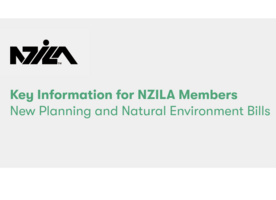News
Counting down to the 2021 NZILA Firth conference
Posted 12 11 2020
in News

Dr Hannah Hopewell from Te Kura Waihanga-Wellington School of Architecture at Te Herenga Waka-Victoria University of Wellington is the chair of the creative panel charged with shaping the content of the conference.
It goes without saying that much has been lost and missed this year due to Covid-19 and the NZILA Tuio Pito Ora 2020 conference was just one of the events cancelled.
But planning is in full swing for next year with the 2021 NZILA Firth Conference to be held in Tauranga on the 6th and 7th of May.
The theme is Radical Reorientation Te Rangitāmiro and is a continuation of the themes that were discussed both at Auckland 2018 and Christchurch 2019. Organisers say It is an opportunity to hear thought-provoking ideas and experiences from leaders and collaborators involved in issues impacting the present and future of Aotearoa's landscape.
Tauranga is the venue for the 2021 conference.
The deadline for abstracts is tomorrow (Friday 13 November) with organisers seeking reflective presentations which draw from practice, projects and research experiences. In addition to landscape architects and planners they are welcoming submissions from activists, lawyers, artists, scholars, and writers. You can find more information on the call for abstracts here.
Dr Hannah Hopewell from Te Kura Waihanga-Wellington School of Architecture at Te Herenga Waka-Victoria University of Wellington is the chair of the creative panel charged with shaping the content of the conference.
She says the objectives of the Creative Panel are to use knowledge and skill-set of its members to make recommendations around themes, speakers and the creative aspects of NZILA events.
“This is to ensure that the events are appealing, educational and interesting to both members and other industry-affiliated professionals.”
LAA set out to find out more about Dr Hopewell.
LAA - Could we get a potted history of your background ?
HH - I currently live in Te Whanganui-a-Tara and work as an academic at Wellington School of Architecture. Yet I have mainly lived in Tāmaki Makaurau other than several stints in California and Spain. I am the middle sibling of 5, and grew up in what was a full and busy household - made more so by our artist father treating the entire house and garden as if it was his experimental studio. Our anthropology-trained librarian mother was not quite so commanding of family space, yet ensured ever-renewing mountains of books were as important as food in the fridge. As a child I loved to read, but spent most of my time outdoors playing in the street, picking flowers and leaves, watching the insects and wading about with the tuna at the nearby muddy foreshore. I find nonhuman worlds, or an awareness of the materiality of worlds that fall outside what might be normatively deemed social endlessly fascinating. Perhaps that’s just a ‘grown up’ way of saying I still like to hang out on the foreshore landscape and watch the quiet action.
Driven by curiosity and ideas, my career has taken a nonlinear path. I initially studied sociology, geography and economics, yet when I discovered Landscape Architecture was to be offered at Unitec in the late 90’s I jumped at it. I didn’t really know what landscape architecture was other that it involved plants, space and relationships between things – it wasn’t garden design and somehow involved the urban. I suspect it was something between Burle Marx’s Copacabana beachfront paving, Charles Jenk’s Garden of Cosmic Speculation and Robert Smithson’s Spiral Jetty that allured me. This appeal however grew in to a deeper interest with the very idea of landscape itself, and how as construct it regulates relationships and agencies with land. Whilst at Unitec I had two daughters and was travelling a lot, so it took me a little longer than most to complete the degree. I worked for Encompass Landscape Architects whilst studying, and upon graduating practiced under the name Morph Landscape Architects until 2004, when I had the opportunity to concentrate my interest in cities and urban landscapes through a newly offered Masters of Urban Design at University of Auckland. Following the Masters I worked for Jasmax on a very diverse range of projects and scales crossing urban design and landscape, until again travel interrupted my paid work. After a period in Spain I returned to Tāmaki Makaurau and deepened my experience in city-making by taking up an urban design role for Auckland Council. On one level I was captivated by the processes of governance and property development, and learnt a lot, yet became increasingly creatively frustrated. I found myself drawn to further study and the creative potential of expanding what could be meant by landscape practice, so began a doctorate in Spatial Design at AUT whilst remaining a consultant to council. This creative-practice inquiry retained a focus on urban waterfronts, yet developed new ‘tools of thought’ and shifted from design as is commonly understood, into a speculative and experimental word and image project. Undertaking the doctorate gave me immense freedom, and once more circumstances took me offshore this time to base myself in San Francisco. It was several years of ‘wandering’ before I chose to return to the rigours of paid work which has seen me settle at Victoria. If I was to consolidate what persistently drives my landscape inquiry, it is the politic of seeing and thinking landscapes, and how qualities of the social manifest through the landscape in unforeseen ways.
LAA - What is the role of the Creative panel in connection with next year’s conference?
HH - The Creative Panel’s role is to come up with the theme, the speakers, and any other creative aspects of the Conference. Most of the thematic, writing and speaker list work was done at the end of 2019 when the Panel comprised of Mark Fletcher, Hannah O’Donoghue, Rangitahi Kawa, Myles Rabbidge, Megan Wraight and myself. The Covid situation of course halted progression until we regrouped in August this year – sadly without Megan. Also Myles took on other commitments, so we have since been joined by Richard Hart and Gerard O’Connell. It must be said that Megan was instrumental in bringing the theme, Radical Reorientation, into being. Her bountiful and infectious energy is held within its intentions, and her desire to inspire collaboration at the heart of the wānanga’s kaupapa. Upon review, it was unanimously decided not to alter the originally drafted theme, but continue with Radical Reorientation as Megan had envisioned.
LAA - The theme is Radical Reorientation Te Rangitāmiro - what are you hoping delegates will get from this?
HH - Radical Reorientation essentially emerges from reflection upon the 2019 conference. Disruption, was a stimulating conference and touched upon a number of deep issues impacting the field - issues such as spatial justice, decolonisation, biodiversity loss, the climate crises to mention a few. We felt with respect to the NZ context these issues needed recognition and critical focus. In that regard Radical Reorientation offers an exploration of our changing world, and how our landscape practices and knowledge need to adapt with care to meet such an array of localised urgencies. On the one hand the wānanga offers a kind of ‘stock-take’ of our field, a space to kōrero and reflect with the multitude of voices that overlap with landscape architecture practices. On the other, an opportunity to share, co-create or re-imagine responses to the diverse demands of change. Whilst the very premise of change is multifaceted, we see it anchored to concrete happenings impacting landscape practice, for example, RMA review, National Policy Statements for Freshwater Management and Urban Development, legal personhood of living entities, Te Ao Maori, food sovereignty, community space, land alienation etc, and now of course the Covid pandemic. Radical Reorientation aims to affirm that in a global context NZ is viewed as leading aspects of environmental governance and decolonisation. With invited speakers across ecology, art, law, design, engineering and activism, we hope to build from this platform and advance dialogue on how landscape architecture might further adapt across landscape design and management. The programme is shaping up well to promote sharing across difference – we expect that lively discussions will be had! Aside from invited local and international speakers that will be announced in due course, the Call for Abstracts has attracted some terrific proposals. There is still time to submit with an extended cut off.
LAA - The pandemic changed the timing of the conference - is it changing the substance?
HH - Yes the pandemic changed the conference timing, but we have not made it an explicit focus of the conference. We anticipate a number of speakers to speak to it, but in the overall context of change.
LAA - Travel is obviously an issue - will there be international speakers?
HH - The Covid situation has certainly determined this will be a different kind of event. As mentioned above, the theme was generated prior to Covid, and in keeping with its intent we wanted to build on the incredible people and knowledge we have here locally. We felt too often the richness in plain sight is glossed over in pursuit of an overseas expert. Having said that we value international context and there will be a number of invited practitioners and thinkers from USA, South Africa, Australia and the UK joining us live by way of zoom. International presenters have been selected due to the insight their projects offer the issues we are canvassing, and many have expressed delighted surprise that we would consider their work in the context of our own. It is indeed heartening to be reminded the world considers NZ advanced in this way, but also timely to speak to the reality of our landscapes and inequalities. We are excited by the prospect international and local dialogue will bring.
LAA - In this time of Covid - what role are events like the conference playing for the LA profession?
HH - Not sure how to answer this question in such an unprecedented times as experience across the profession has been so diverse. Some have been so swamped in overwork and the juggle of competing needs they are likely to view the conference as an opportunity for a break! Whilst others have had more reflective time than perhaps they would like, and will be rearing to actively participate. Overall however the conference plays a critical role in shaping up and articulating the identity and community of practices of not just landscape architecture per se, but landscape architecture in Aotearoa here and now.
16 Dec
National hui on RMA reforms - register now

Your prompt response appreciated
Last Thursday we shared an update outlining the Government’s proposed replacement of the RMA and the significant implications these Bills …
10 Dec
Proposed replacement of the RMA: Planning Bill and Natural Environment Bill

A message from the Environmental Legislation Working Group
On Tuesday this week, the Government released proposed bills to replace the Resource Management Act 1991. Reform of our planning …
03 Dec
Newly Registered Landscape Architects 2025

Celebrating professional achievement across Aotearoa The 2025 Registration process is now nearing completion, and we are delighted to acknowledge the …
Events calendar
Full 2025 calendar